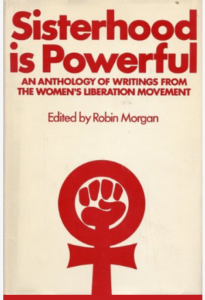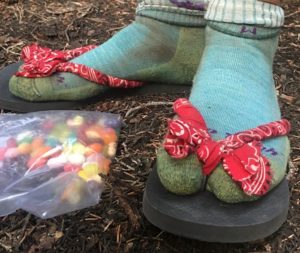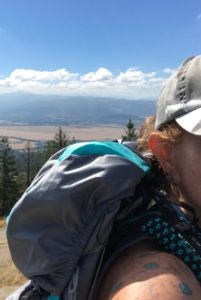Category — Taking on challenges
And so it begins
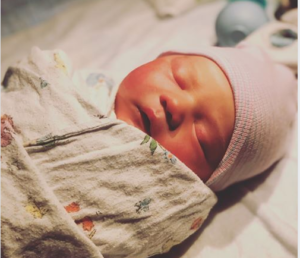
On July 12, 1817 Henry David Thoreau entered the world. On that date in 1864, George Washington Carver was born. Forty years later, Pablo Neruda joined the human race.
Among the more than 390,000 humans to make their first appearance on our planet on July 12 of this year, 2020, was Henry Burns Hager: fat-cheeked, silky-haired with a cupid-bow mouth and perfect seashell ears.
He arrives healthy in the midst of a raging pandemic. He arrives cherished and embraced in a time of deep division and scarring incivility. He arrives with all the promise of the future at a time when the future feels troubled and fragile. In arrives in hope at a time of fear.
His parents are two of the most extraordinary human beings I know. I would say this, truly I would, if I were not related to them.
But I am.
Henry’s father is our son, my middle child. Henry’s mother is my daughter-from-another-mother. (The “in-law” designation doesn’t fit at all, as if a document unites us rather than our hearts.) These two, separately and together, are compassionate, big-hearted, kind, thoughtful, funny, smart, loving, adventurous, quirky, resilient. And more. I could pile up the adjectives. But you get the idea.
Henry enters the world with privilege. I am referring not to the privilege of his sex, race and class, enormous as they are, but to the privilege of being born to these parents.
Welcome to the world, Henry Burns Hager. Make it a better place.
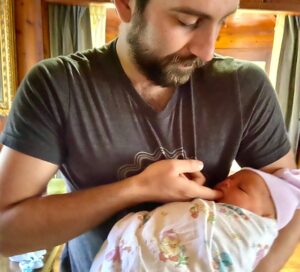

July 15, 2020 11 Comments
Risk and Resilience
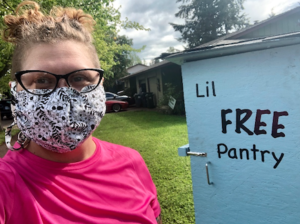
I’ve been thinking (and talking and writing) a lot these days about the “lessons” we are–or should be–learning from this pandemic. For example:
Don’t empower and support an aggressively ignorant, amoral sociopath to be your leader in time of crisis. Or any time.
Don’t treat the elderly as if their lives don’t matter. Don’t warehouse them in “facilities” and then underpay and undervalue those who care for them.
Don’t incarcerate 2.3 million people and crowd them into unsafe, unhealthy, hostile places that are cages within cages.
Don’t ignore the horrible irony of asking people to #stayhome when more than 4 million people are homeless.
We are learning other lessons too. We are learning how compassionate and generous people are. And we are learning how nasty and stupid people can be. We hear about the owners of shuttered restaurants cooking and delivering meals to health care workers. We see protestors with Nazi signs and assault rifles calling for “business as usual” on the steps of state capital buildings. We learn of teachers making daily calls to every one of their students to check up on them. We read about the murder of a security guard at a Family Dollar Store, shot after denying entry to an unmasked customer. We are learning who we are, for better and worse.
I think there is also a long-term lesson to be learned about R&R. No, not Rest and Relaxation. I mean Risk and Resilience.
We are living through a time of great risk. This is not just risk to our physical health but also to our emotional and psychological well-being. And it is not just a risk to our personal health but to the moral health of our nation.
One response to risk is fear. (This shuts down meaningful thought and thoughtful action. Another response is claiming victimhood. (Surely someone is responsible for putting me at risk. Who’s to blame?) Another is purposeful, aggressive ignorance. (Risk? What risk? I am okay. That’s what matters.)
I would like to suggest another response: Resilience. This is a mindset that empowers us to see ourselves as actors who make things happen, not victims to whom things happen. Resilience is the ability to bend, to remain supple and flexible, to spring back. Resilience means developing goals instead of focusing on barriers. It means recovering by taking clear-headed, decisive action.
Resilience, say those who study it, is a combination of optimism and endurance. Optimism is not a looking-at-the-world-through-rose-colored-glasses thing. It’s more a belief in your own efficacy. And endurance is not some nose-to-the-grindstone slog through change and challenge. Endurance is what naturally occurs when you have–and decide to pursue–a worthy goal. All of this can be learned. Yes, learned.
And this pandemic, this crisis, is a perfect opportunity for us to do so. As individuals. And as a nation.
What is your resilient response? What should be our country’s?
The image above is of (and taken by) my friend, my Food for Lane County Dining Room colleague, and one of the most resilient, generous and loving people I know, Angie Godlasky. Among her many resilient responses is this pop-up pantry in her front yard that offers free food for those in need.
May 6, 2020 1 Comment
We care
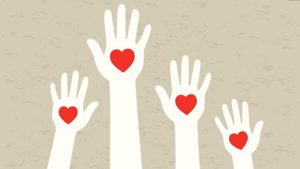
“In every crisis, doubt or confusion, take the higher path
– the path of compassion, courage, understanding and love.”
― Amit Ray
Yes, there is the guy who drove around Chattanooga buying every bottle of hand sanitizer on the shelves at Dollar Tree, Walmart, Staples Home Depot, and then, having created a shortage, took to the highway with a loaded UHaul price-gouging his own community. Yes, there are the hucksters who rushed to the internet to sell flimsy, useless face masks. Yes, there is panic-buying, hording—even fighting—in grocery stores.
But, my friends, there is also generosity and compassion, thoughtfulness and community-mindedness. There are humans being kind to humans. Because, despite the White House-fueled incivility and vitriol that has become the “new normal,” despite the real and evolving health (and attendant financial) crisis posed by the coronavirus, this is what we humans do. We care about—and for—each other.
Let’s take a moment to recognize, celebrate and support the generous and compassionate actions of others, both big and small.
In Eugene, Bagelsphere is home-delivering a dozen bagels for free to any senior who cannot or does not want to risk going out to shop.
Eugene-based Oregon Community Credit Union (owned by more than 150,000 members) has told its mortgage customers that they can skip April payment with no penalty or fees.
Laughing Planet is offering free meals to school kids on meal assistance programs at all its Pacific Northwest locations.(Students are not required to show proof that they are part of a meal program.) In Lincoln City, OR, Grill 1646 is giving away hotdogs and PB & J’s to homeless students who will be unable to get free meals due to school closures.
Shine Distillery and Grill in Portland is making its own hand sanitizer and giving it away for free. (The product comes from the process of distilling their own spirits.)
Seattle-based REI has closed all its retail stores—and will continue to pay all its employees during the closure.
Trader Joes has expanded its paid sick time to all of crew members.
And then there are the grander gestures:
Zion Williamson, the 19-year-old superstar of the Pelicans basketball team, announced that he will cover the salaries of all laid-off workers at the Smoothie King Center in New Orleans for the next month.
That’s the most dramatic move in the world of professional sports, but the following teams have also pledged to support the (mostly hourly-paid) stadium and arena workers out of work due to game and tournament cancellations: Dallas Mavericks, Houston Astros, Indiana Pacers, LA Clippers, LA Lakers, Golden State Warriors, Miami Heat, Milwaukee Bucks, Detroit Pistons, Chicago Bulls, Cleveland Cavaliers, Brooklyn Nets, Atlanta Hawks…the list goes on.
Renowned Washington, D.C chef and restaurateur José Andrés announced that he was transforming some of his restaurants into community kitchens to offer lunches for those in need of a meal.
What is happening in your community? How can you help?
March 18, 2020 No Comments
Look forward, angel
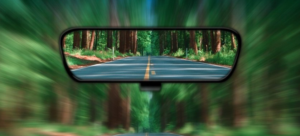
We can—and should—learn from the past. We can—and should—examine our lives. (The unexamined life is not worth living, Socrates famously said.)
But I wonder. I wonder about all this re-living the past, this ruminating (in the cud-chewing sense) and this continued obsession (both of writers and apparently of readers) with memoir. I belong to a Facebook group, Binders of Creative Nonfiction, and it seems to me that 90 percent of what the women—thoughtful, generous, lovely souls as far as I can tell–are posting about, asking questions about, ”humble bragging” about is memoir. Creative nonfiction—or as I prefer to call this genre I have been working in for my entire writing life—narrative nonfiction, is so much more. It is (or can be about) going out into the world and discovering the lives others live and how and why they live them, the communities they are part of, especially communities hidden from view. We learn more about ourselves that way, too, but we get to look both outward and inward.
I think the reason I am concerned at this moment is that I feel the overwhelming need for us to look forward, not back, to imagine futures, not dwell in the past.
It’s about politics, of course. It’s about 2020 and moving beyond the evil and idiocy of the current government. It’s about not chewing over (and, in some odd way, relishing the taste in our mouths) of this terrible, terrible time. It’s about believing in goodness, in actively, forwardly joining together to make that happen.
But it is also (in the spirit of memoir I just finished criticizing and yet right here am practicing!), about my own life. About what has happened, just recently, that has jolted me, that made me want to chew the cud and re-live what was and is no more, that made me, in my darker moments (that would be 3 am) replay, rewind, replay, rewind and (in my truly dark moments) construct elaborate revenge scenarios.
What I should be doing, what I am now pledging to do, is to stop expending energy on the past I can’t change and use it all—and if you know me, you know I have a lot of it—on the good I can do now.
November 13, 2019 6 Comments
Stand up. Speak out.
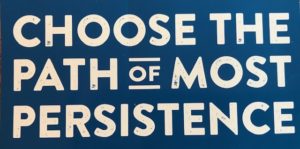
The powerful control the powerless. The rich control the poor. The free control the enslaved. Those with money control politics. Those with keys control access.
I’ve been thinking a lot about control lately having just experienced its heavy hand. Not in exercising it but in the having it exercised upon me. There’s a Japanese proverb, “the nail that sticks out gets hammered.” Deviance is met with resistance. Voices raised are met with efforts to seize the microphone.
This has not stopped us. This will not stop us.
This is not a threat. This is a promise.
November 6, 2019 2 Comments
Falling in love again
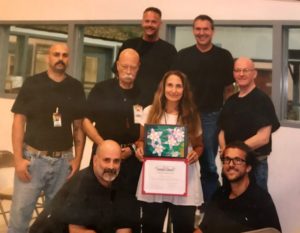
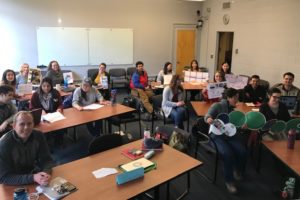
I’ve fallen in love with teaching again.
For this I owe a debt to the smart, creative, focused “stories spark change” graduate students in my University of Washington CommLead storytelling seminar. They are public radio journalists, freelancers, videographers, nonprofit communications specialists, techies, veterans, mothers, fathers. They work all day. Then they spent high-energy Saturdays with me delving into the art and craft of narrative, learning how to tell important stories in compelling ways. And no one nods off. And when five o’clock comes, no one rushes for the door.
And I owe a debt to the forward-thinking, “best and brightest” Austrian journalists I work with, both in Europe and in Seattle, who do not have to be persuaded that journalism matters. They know it does. They live it every day.
But my biggest debt is to the men in my writers group at Oregon State Penitentiary, felons all, murderers most, and some of the best read, most thoughtful, most attentive, most generous, most open to (craving of) constructive critique of any group I’ve ever worked with. Every hour spent with them—and I’ve spent hundreds during the past four years—has been inspiring, enlightening, harrowing (not for my safety but for the stories I hear) and bone-deep satisfying.
There was a time, four or five years ago, when my love of teaching (long a complement to my writing life) was at an all-time low. I was unhappily immersed in “academic life” (which, alas, is not synonymous with teaching) as a full-time full professor. I was expending energy fighting for programs I believed in (and generally losing). I was wasting time (and becoming the kind of person I didn’t want to be) battling over turf. I was spending far too much time sitting in meetings where the people who actually held the power pretended that you had a say. I was working with people who pretended to like each other but didn’t.
I should have left before I did. But that regret has now been effectively scoured. I have learned—these new students of mine have taught me—how to love teaching again.
March 6, 2019 5 Comments
Sisterhood is powerful
Sisterhood is Powerful, the book, was the first comprehensive collection of writings from second-wave feminism. Cited by the New York Public Library as “one of the 100 most influential books of the 20th century,” it was edited by Robin Morgan, one of the founders of what was then called the Women’s Liberation Movement. She continues to be an international voice for women’s empowerment, a forever kickass feminist, an in-it-for-the-long haul force of nature.
I’m referencing her today because of her recent long, impassioned, full-of-empowering facts blog about the mid-term election “Blue Wave” and how women surfed it.
For those of us who bit our nails to the quick last Tuesday night, hoping for a tidal wave that would submerge (okay, drown) those who currently have a stranglehold on our country, there were some disappointments. We wanted the Senate AND the House. We wanted Claire McCaskill. We wanted Heidi Heitkamp. Stacy Abrams. But we barely had time to consider what we had won before the hate-mongerer in the White House did his usual “no, look over here” trick of waylaying the media and our attention.
Robin’s blog reminds us to revel in the victories of the 2018 midterm, especially as they relate to women. (Here are other reports about this historic moment.)
Consider that 256 women were candidates for the U.S. House or the U.S. Senate in the general election—a record-breaking number–and as of Nov. 13, 114 were victorious. That includes the Arizona Senate race, in which U.S. Rep. Kyrsten Sinema was declared the winner on Monday. The 116th Congress will see the largest class of female lawmakers ever. (And the number may grow as several House races have still not been called.)
And the women elected are a diverse group. There are two Muslim women, two native Americans, and two Latinas. In all, Robin reports that 42 women of color were elected, and “at least” three lesbians. There are new female members from the red states of Kansas, Iowa, Florida, Texas, Georgia and Oklahoma.
Wow. Just wow.
Also, Robin reminds us that a record number of women ran for state legislatures–3,388 —and according to the National Conference of State Legislatures, more women will serve in state legislatures come January than at any point in American history.
Sisterhood is indeed powerful.
November 14, 2018 No Comments
Anticipation
It is one day, almost exactly 24 hours, before we leave for our “we’ve all come to look for America” “discovering the land between two coasts” “what’s up with this country anyway?” “deTocqueville meets William Least Heat Moon” cross-country trip. We’ll be car-camping across the northern heartland on the only non-freeway, old-style 2-lane road in the U.S. that runs from coast to coast.
No, not Route 66, the “Mother Road.” That ran only from Chicago to California and is now chopped up anyway. I’m talking about humble route 20, which starts in Newport, Oregon, traverses the vast, sparsely populated, deep Red width of Oregon, then meanders through the girth of Idaho, dips into Yellowstone, makes its way across the sandhills of Nebraska, into Iowa (Fort Dodge!), then a snippet of Illinois (beginning with the lovely town of Galena, birthplace of U.S. Grant). Then it’s northern Indiana and Ohio (can you say audiobook) before ambling through the New York Finger Lake region (and Seneca Falls, birthplace of the woman’s suffrage movement) and into the Berkshires of Massachusetts (yes, the Camp Tamarac of my youth). Route 20 ends, 3,365 miles later, in Boston.
Am I excited? Buoyed by anticipation? Hell ya.
In fact, research shows that this is the happiest I am going to feel about this adventure. A study by Netherlands social scientists (they interviewed more 1,500 people) found that vacationers were most happy before their trips. Planning, anticipation, thinking about all the fun and adventure—that’s the best. The trip itself? Who knows? Tedium, bad diner food, frigid mornings in the tent, domestic squabbles. Just sayin.
So right now, this moment, I’m going to enjoy the hell out of this trip.
More to come.
August 29, 2018 7 Comments
Hiking the PCT
Approximately a zillion years ago, I wrote a book ON A TYPEWRITER. It was a brisk 20th century history of U.S. political dissidents and cultural outsiders, and the newspapers and magazines they started to promote their causes. Each of these groups was itself a subculture—abolitionists, utopianists, feminists, war resisters—but within the subculture, there were invariably splits, splinters and “purges.” I wrote about Marlenites and their little newspaper. The Marlenites consisted of a few members of the Marlen family. They were a splinter group of a splinter group of a splinter group of the American Communist Party.
Oddly, I was thinking about all this as I hiked a stretch of the Pacific Crest Trail (PCT) these past few days. We (son, daughter-in-law, son) had already played twenty questions, name that tune and Stinky Pinky, and there were many miles to go before we made camp. Trudging through scraggly pine forests (I am a Doug Fir girl) with a 28-pound pack on my back, what else was I to do other than contemplate dissident journalism?
Thinking about these splinter groups, these sub-cultures of sub-cultures, my thoughts turned to the PCT subculture. For those who’ve never been on the trail—it stretches 2,650 miles from the Mexican to the Canadian borders (and no, Cheryl Strayed did not hike its entirety)—let me give you a snapshot: PCTers are overwhelmingly white, educated, moneyed, late 20s to mid-30s, and, not surprisingly, leaner and healthier than almost everyone else in America. Of course, there are exceptions. Me, for example. (Just the age thing. Oh, and the lean thing.)
As I learned the lore of the trail from Zane and Liza who had started at the Mexican border back in late April, I began to understand PCTers as less homogeneous than I originally thought. Yes, they were mostly white, educated, moneyed, lean and thirty, but there were thru-hikers and section-hikers and day-hikers. There were SOBOS (southbound) and NOBOS (northbound). There were slack packers (someone else transported their packs for them). There were ultralight folks (base weight of pack 10 pounds or less). There were yellow blazers (they cheat by hitchhiking), blue blazers (they take short-cuts) and pink blazers (they’re on the prowl for, um, tent-mates).
And it seemed that people within each group had strong opinions about people in the other groups. Thru-hikers were the real deal. They considered section-hikers inferior beings. Repeat thru-hikers were really the real deal. They considered everyone else inferior beings. SOBOS ranked higher on the PCT-o-meter than NOBOS. Ultralighters were admired by others, but not as much as they admired themselves. And so it went. A tiny subculture (a few thousand hikers, maybe 700-800 who attempt thru-hiking ) splintering into sub-group after sub-group.
If you don’t see the connection between PCT culture and dissident journalists, you would about 17 miles down a hot trail with a (did I mention?) 28-pound pack on your back.
(photo: Camp feet with Jelly Bellies. All hail Darn Tough socks)
August 22, 2018 No Comments
Thank you, Emma
Emma Gatewood was the first woman to hike the entire Appalachian Trail (2,168 miles). If you read about her, the first thing you’ll read is that she was 67 at the time, and then, because she’s a woman, you will read about how many children and grandchildren she had.
But here’s the most startling thing about Emma Gatewood’s 1955 trek: She wore Converse sneakers and carried an army blanket, a raincoat, and a plastic shower curtain in a homemade denim bag slung over one shoulder. That’s how she hiked. Damn.
At this very moment, a year from now, I will be hiking the Oregon section of the PCT, all 460 miles of it, from the Siskiyou Summit north across the crest of the Cascades to the Columbia River. I hesitated with the verb tense in the previous sentence. I will be. I considered writing “I might be” or “I hope to be” or some other waffle-ly statement. But I want to declare this intention without wiggle room.
I made the declaration to myself yesterday as I trudged up our access road for my first practice hike, a five-miler over to and up Spencer Butte with a lightly loaded pack. I’ve hiked a lot, including some tough backcountry day hikes in the Kootenays of British Columbia and the red rock country of southern Utah. The operative word there is day hikes.
I have only once in my life hiked, camped and then hiked some more, and that was back before the invention of moveable type. On my various day hikes since that time, I’ve never carried more than one of those little Camelback hydration packs. Yesterday I hoisted on, cinched in, buckled up, etc. a serious through-hike backpack, one of several pieces of gram-shaving high-tech equipment I’ve been acquiring.
I plan to hike only the Oregon section – a third of Emma’s mileage – and I plan to outfit myself with ultra-light gear that will not include shower curtains.
Why the Oregon section? It’s my homage to the state I fell in love with at first sight, the state that’s been my home for pretty much all of my adult life, the state that continues to leave me breathless with its beauty (and generally the politics ain’t bad either). Also, hiking the entire PCT takes more than 5 months. The Oregon section… maybe 5 weeks. Note that one of my reasons is NOT “I couldn’t possibly hike the entire PCT.” Maybe I could. Maybe I couldn’t. After I complete the Oregon section, I’ll know better.
Why do this at all?
To see if I can.
Because of Emma Gatewood.
And because, as Gandhi famously said: “You must be the change you want to see in the world.” And I want to see the end of ageism.
July 11, 2018 No Comments

